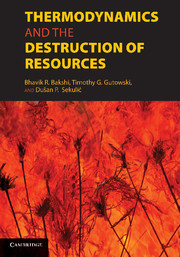Book contents
- Frontmatter
- Contents
- Contributor List
- Foreword by Herman E. Daly
- Foreword by Jan Szargut
- Preface
- Introduction
- PART I FOUNDATIONS
- PART II PRODUCTS AND PROCESSES
- 4 Materials Separation and Recycling
- 5 An Entropy-Based Metric for a Transformational Technology Development
- 6 Thermodynamic Analysis of Resources Used in Manufacturing Processes
- 7 Ultrapurity and Energy Use: Case Study of Semiconductor Manufacturing
- 8 Energy Resources and Use: The Present Situation, Possible Sustainable Paths to the Future, and the Thermodynamic Perspective
- PART III LIFE-CYCLE ASSESSMENTS AND METRICS
- PART IV ECONOMIC SYSTEMS, SOCIAL SYSTEMS, INDUSTRIAL SYSTEMS, AND ECOSYSTEMS
- Appendix: Standard Chemical Exergy
- Index
- References
4 - Materials Separation and Recycling
Published online by Cambridge University Press: 01 June 2011
- Frontmatter
- Contents
- Contributor List
- Foreword by Herman E. Daly
- Foreword by Jan Szargut
- Preface
- Introduction
- PART I FOUNDATIONS
- PART II PRODUCTS AND PROCESSES
- 4 Materials Separation and Recycling
- 5 An Entropy-Based Metric for a Transformational Technology Development
- 6 Thermodynamic Analysis of Resources Used in Manufacturing Processes
- 7 Ultrapurity and Energy Use: Case Study of Semiconductor Manufacturing
- 8 Energy Resources and Use: The Present Situation, Possible Sustainable Paths to the Future, and the Thermodynamic Perspective
- PART III LIFE-CYCLE ASSESSMENTS AND METRICS
- PART IV ECONOMIC SYSTEMS, SOCIAL SYSTEMS, INDUSTRIAL SYSTEMS, AND ECOSYSTEMS
- Appendix: Standard Chemical Exergy
- Index
- References
Summary
Introduction
In this chapter, we develop several models for the materials-recycling process. The focus is on the separation of materials from a mixture. This problem can be modeled by using the principles of thermodynamics, particularly the concept of mixing entropy, as well as by using some of the results from information theory. In doing this calculation we will find, from a thermodynamic point of view, that the theoretical minimum work required for separating a mixture is identical to the work lost on spontaneous mixing of the chemical components. In other words, the development in this chapter in conjunction with the results from previous chapters will allow us to track both the degradation in materials values as they are used and dispersed in society as well as the improvement and gain as materials are restored to their original values. Of course, this restoration does not come for free, and so we also look at the losses and inefficiencies involved in materials recycling. This approach allows us to look at the complete materials cycle as it moves through society and to evaluate the gains and losses at each step. The chapter starts with the development of the needed thermodynamics concepts and then moves on to the application of these ideas. This chapter also introduces an alternative way of looking at the recycling problem by using information theory.
- Type
- Chapter
- Information
- Thermodynamics and the Destruction of Resources , pp. 113 - 132Publisher: Cambridge University PressPrint publication year: 2011
References
- 8
- Cited by

